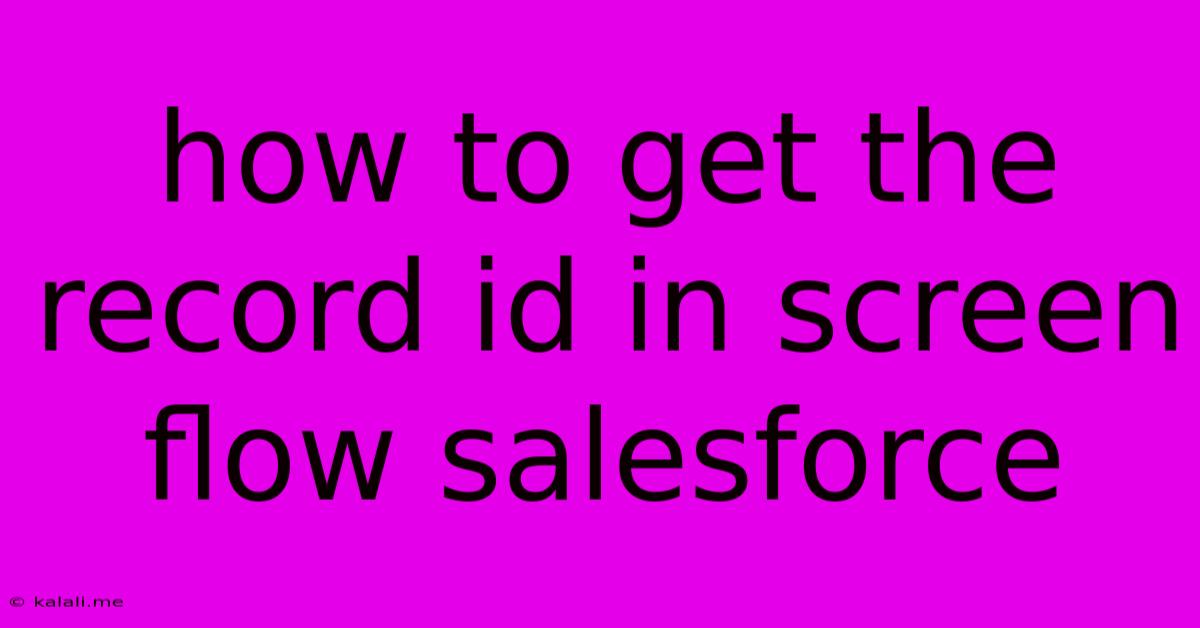How To Get The Record Id In Screen Flow Salesforce
Kalali
Jun 05, 2025 · 4 min read

Table of Contents
How to Get the Record ID in a Salesforce Screen Flow
Getting the Record ID within a Salesforce Screen Flow is crucial for many automation processes. This allows your flow to interact with specific records, updating fields, creating related records, or initiating further actions based on the selected record's data. This guide will walk you through several methods to achieve this, covering various scenarios and best practices.
Meta Description: Learn how to retrieve Record IDs in your Salesforce Screen Flows. This comprehensive guide covers multiple methods, ensuring your flows seamlessly interact with specific records for efficient automation.
There are several ways to capture a Record ID within a Screen Flow, depending on how the user interacts with the flow:
Method 1: Using a Record Variable from a Flow's Starting Point
This is the most straightforward method if your flow is initiated from a record page, such as a button click on an Account or Contact record.
- Start Element: Begin your flow with a "Record Choice" or a "Record Trigger" element. This element automatically passes the record ID of the record that initiated the flow.
- Record Variable: This element will automatically create a record variable (e.g.,
myRecord). You can access the Record ID using the formula{!myRecord.Id}within subsequent elements of your flow. This formula can be used in assignment elements, decisions, or formula expressions throughout the flow to reference the record ID. - Subsequent Elements: Utilize the
{!myRecord.Id}formula in subsequent flow elements to perform actions based on the record ID, such as updating related records, or querying information using a Get Records element.
Method 2: Using a Screen Component and Formula Resource
This method provides more flexibility if the Record ID isn't directly passed from the flow's start element.
- Screen Component: Add a Screen component to your flow.
- Input Field: Include an input field on the screen for the user to enter the Record ID. The input field should be assigned to a text variable in your flow (e.g.,
recordId). - Formula Resource: While not strictly required, utilizing a Formula resource can enhance readability and maintainability. Create a Formula resource which simply returns the value of the
recordIdvariable. - Flow Logic: Use the formula resource (or the
recordIdvariable directly) in your flow logic where needed.
Method 3: Using a Record Lookup in a Screen Component
This method is ideal when users need to select a record from a list.
- Screen Component: Add a screen component with a lookup element. This element allows the user to search for and select a record.
- Record Variable: Configure the lookup component to assign the selected record to a record variable (e.g.,
selectedRecord). - Access Record ID: Use the formula
{!selectedRecord.Id}to access the Record ID of the chosen record in subsequent flow elements.
Method 4: Using the Get Records Element and a Filter
This method dynamically retrieves the Record ID, but requires additional information to uniquely identify the record.
- Get Records Element: Add a "Get Records" element. Configure it to query the object containing the record you need.
- Filter Criteria: Define a filter criteria to uniquely identify the target record. This will likely involve fields like Name or other unique identifiers.
- Record Variable: The "Get Records" element will assign the retrieved record(s) to a record variable (e.g.,
retrievedRecord). Use{!retrievedRecord[0].Id}to access the ID of the first record retrieved. Ensure your filter is specific enough to return only one record to avoid errors.
Best Practices and Considerations
- Error Handling: Implement error handling to gracefully manage scenarios where the Record ID is missing or invalid. This can be achieved using decision elements within your flow.
- Data Security: Ensure the flow only accesses data that users are authorized to view or modify.
- Clear Variable Naming: Use descriptive variable names to improve flow readability and maintainability.
- Testing: Thoroughly test your flow with various scenarios to ensure it functions correctly.
By following these methods and best practices, you can confidently incorporate Record ID retrieval into your Salesforce Screen Flows, significantly expanding the capabilities of your automation. Remember to choose the method most suitable for your specific flow design and user interaction.
Latest Posts
Latest Posts
-
Python Moving An Object Class In X And Y Direction
Jun 07, 2025
-
2 Lights 2 Switches 1 Power Source Wiring Diagram
Jun 07, 2025
-
How To Clean Ceramic Range Top
Jun 07, 2025
-
Word For Someone Doing Business For
Jun 07, 2025
-
Til There Are No Skill Checks Just Ability Checks
Jun 07, 2025
Related Post
Thank you for visiting our website which covers about How To Get The Record Id In Screen Flow Salesforce . We hope the information provided has been useful to you. Feel free to contact us if you have any questions or need further assistance. See you next time and don't miss to bookmark.